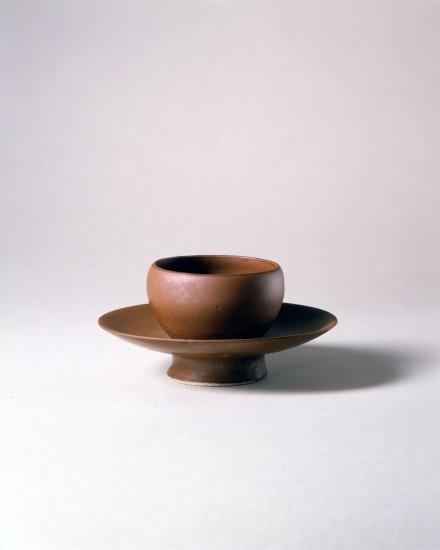J.J. Lally & Co., Oriental Art / New York City, New York
MenuPast Exhibition
Chinese Ceramics A.D. 400–1400:
Selections from an American Collection
March 19 - 31, 2007

12.
A RUSSET-GLAZED DINGYAO CUPSTAND
Northern Song Dynasty, A.D. 11th Century
the finely potted deep cup-shaped support with steeply rounded sides rising to a wide mouth with incurved rim and joined to a wide circular saucer supported on a tall hollow foot with splayed edge, covered all over in a rich reddish-brown glaze thinning around the rims to reveal a very dark brown glaze beneath the slightly iridescent russet-colored surface, and with the pale body showing through at the edges, the neatly finished knife-pared footrim left unglazed revealing the white porcelain body.
Diameter 5 1⁄8 inches (13 cm)
From the Collection of Robert M. Ferris IV, Windsor, Vermont
A very similar russet-glazed Ding ware cupstand in the Palace Museum, Beijing, is illustrated in the Gugong Bowuyuan Cang Wenwu Zhenpin Quanji, Liang Song Ciqi I, Vol. 32 (The Complete Collection of Treasures of the Palace Museum, Beijing, Porcelain of the Song Dynasty, Book I), Hong Kong, 1996, pl. 86, p. 95.
Another russet-glazed Ding porcelain cupstand of very similar form, formerly in the Collection of Ruth Dreyfus and the Collection of Arthur M. Sackler, and now in the Collection of Dr. and Mrs. Marvin L. Gordon, was exhibited at the Arthur M. Sackler Museum, Harvard University, 1996, and illustrated by Mowry in the catalogue, Hare’s Fur, Tortoiseshell and Partridge Feathers: Chinese Brown-and Black-Glazed Ceramics, 400-1400, Cambridge, 1996, no. 12, p. 103.
Compare also a similar cupstand of slightly smaller size from the collection of Aubrey Le Blond, now in the Victoria and Albert Museum, London, illustrated by Ayers, Far Eastern Ceramics in the Victoria and Albert Museum, London, 1980, no. 83, described as “red Ding” and previously illustrated in the catalogue of the O.C.S. Jubilee Exhibition, The Ceramic Art of China, London, 1971, pl. 47, no.70, described on p. 75 as “brown Ting.” Another cupstand of very similar form, described as “purple Ding,” is illustrated by Krahl, Chinese Ceramics from the Meiyintang Collection, Vol. One, London, 1994, no. 354, p. 202.
The dark-glazed Ding wares which have been variously described as “red Ding,” “brown ding”, “purple Ding” or “persimmon Ding” (kaki-Ding in Japanese usage) all are actually the same rust-brown glaze. Mowry (loc. cit.) traces the source of this confusion in the nomenclature to the very early and influential treatise on connoisseurship by Cao Zhao, the Gegu yaolun (The Essential Criteria of Antiquities) written in 1388. There the author refers to white Ding, black Ding and a third category which is described as “zi” Ding, an ambiguous character which can be used to mean “purple” or “dark brown.” Mowry goes on to point out that in more recent times, Japanese collectors and connoisseurs have referred to the color of the rust-brown glazed Ding wares as “kaki” or “persimmon,” which then might be translated into English as “red.” In an effort to clarify the situation, Mowry proposes “…that pieces with rust-colored glaze be called ‘russet Ding’…”
The similarity of the color of russet-glazed Ding to Song lacquer wares suggests that this Imperial ceramic was made in imitation of a lacquer prototype. Compare a reddish lacquer cupstand of very similar form which was excavated from a Southern Song tomb at Heqiao, Yixing county, Jiangsu province, now in the Nanjing Museum, illustrated in the catalogue of An Exhibition of Art Treasures from the Nanjing Museum Collection, Tokyo, 1989, no. 50, p. 87.
12.
A RUSSET-GLAZED DINGYAO CUPSTAND
Northern Song Dynasty, A.D. 11th Century
Diameter 5 1⁄8 inches (13 cm)